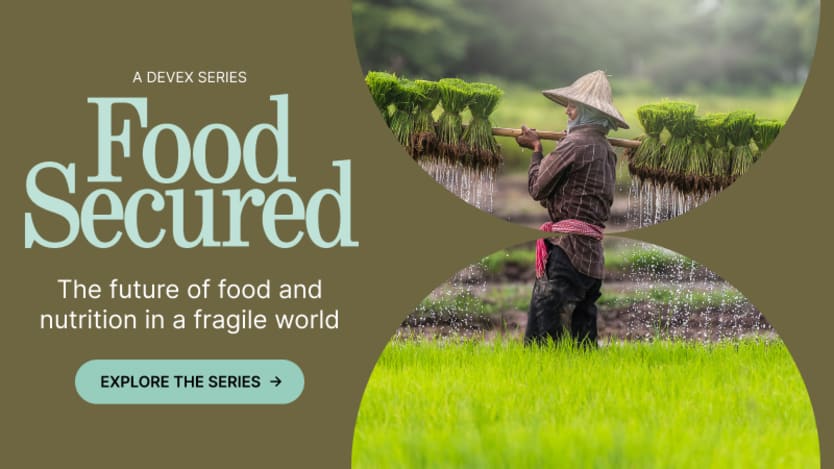
Around almost every corner in New York you can find a good restaurant. I hope world leaders and all those coming for the annual United Nations General Assembly meetings this September take advantage of that while here. What could be better after a long day sorting through the world’s crises and trouble spots than a good meal served well?
As they are handed their menus, I’d like to attach a fact sheet to remind them about one crisis that needs their urgent attention: the global nutrition crisis. That fact sheet would include statistics from areas affected by escalating food insecurity in Africa:
• 23 million people are facing high levels of acute food insecurity in Ethiopia, Kenya, and Somalia alone.
• In the same region, more than 7 million children under the age of 5 remain malnourished and in need of urgent nutrition support, and over 1.9 million children are at risk of dying from severe malnutrition.
• An estimated 970,000 children under five in the central Sahel region will face severe wasting this year.
I wouldn’t do this to make them feel guilty while they dine — guilt isn’t helpful or needed. I’d rather they feel very grateful for the meal set before them and then feel motivated to do even more to make sure children in all parts of the world have enough to eat.
The fact sheet might also remind them that 2023 marks the midpoint of the Sustainable Development Goals since they were approved eight years ago. Goal 2 — yes, second on the list —is to “end hunger, achieve food security and improved nutrition and promote sustainable agriculture.”
To get there — ending hunger — from here requires more action than has been taken thus far. And that action is needed now.
Squandered potential
Here’s the thing about hunger: When a child lacks food and nutrition, it isn’t just a temporary pain they feel in their stomachs. Their future lives and potential are literally at risk.
Poor quality diets are one of the greatest obstacles to child survival and healthy development, and the stakes are highest in the first two years of life, when malnutrition can irreversibly harm a child’s rapidly growing body and brain. We know that poor nutrition impairs cognitive skills among children and adolescents and is a major reason for absenteeism and poor school attendance.
Thinking of all of that, I can’t help but remember one of the families I met in a remote northern Kenyan community called Losol several months ago.
Losol sits on a small hilltop in a desert-like environment, which has been made even drier by the drought of the last few years. There is no water nearby, no latrines, no agriculture, no animals left, very little commerce, and no school, clinic or any other services within a span of many kilometers.
Most people live in small shelters built from sticks and partially covered in whichever materials people find available. But despite the lack of space and resources, some 2,500 people had arrived in the months before I visited to spend the days sifting through the soil around Losol in search of small flakes of gold — not to get rich, but to have enough to eat.
Akalaptan Eeoron was one of them. After the last three of her goats died in her home community due to the drought, she and her four young children moved 15 kms away to Losol. She found only enough gold flakes to exchange for the water and flour that was sustaining her family.
But flour and water won’t do it. It might fill children’s bellies, but it won’t give them the nutrition they need. Without it, what becomes of their potential?
I’m proud of the work that my UNICEF colleagues and our partners are doing to combat this crisis.
Scaling the response
As the world faced a historic food and nutrition crisis — and armed with $766 million in new funding — we worked together to deliver the largest nutrition response on record. We scaled up efforts in the 15 most impacted countries, from Afghanistan to Burkina Faso and Yemen, with interventions to prevent acute malnutrition and provide critical therapeutic foods to treat it.
When there was more demand than supply for those foods, we teamed up with the Bill & Melinda Gates Foundation and UNICEF USA’s own Bridge Fund to accelerate cash to suppliers to help them expand capacity.
We also worked with partners to integrate nutrition services into primary health care, trained mothers and caregivers to identify early signs of malnutrition in their children, and advocated for improved government policies related to feeding practices and breastfeeding.
All of this has helped, but we need more.
This is a global crisis and the years are ticking away to 2030, the deadline to meet SDG Goal 2 to “end hunger.”
To world leaders coming to New York, I say welcome! All the best to you. Be productive while here. Enjoy our good food. Be thankful for it. And recommit to reaching your goal to end hunger. Imagine a world where every child has the nutrition they need to develop a healthy body and mind. What potential for the world that will unlock!
We need to continue to encourage government investment and foreign assistance that supports nutrition and food security for the world’s most vulnerable: women and children. Learn about UNICEF USA’s work on this here.
Visit Food Secured —a series that explores how to save the food system and where experts share groundbreaking solutions for a sustainable and resilient future.
This content is sponsored as part of our Food Secured series, which is funded by partners. To learn more about this series and our partners, click here.









